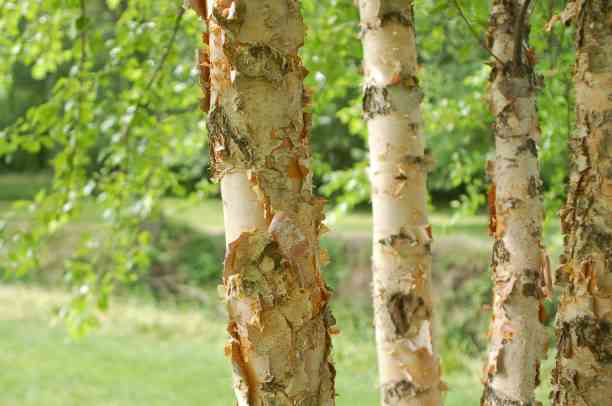Birch Trees Michigan: Homeowner’s Complete Guide

As a Michigan homeowner, understanding birch trees Michigan can help you make smart decisions for your landscaping. These graceful, peeling-bark natives bring beauty through all four seasons—and they also require some special care.
1. Native Birch Species in Michigan
Michigan is home to several native birch species, including:
-
Paper Birch (Betula papyrifera): Known for its peeling, papery white bark, this birch is a fast grower in cool, sunny locales but tends to live only 30–50 years in our state.
-
Yellow Birch (Betula alleghaniensis): One of the tallest birches, reaching up to 80+ ft in ideal settings. Its bronze bark is a signature feature, and it prefers cool, moist soils.
-
Mountain Paper Birch (Betula cordifolia): Very similar to paper birch but with subtle botanical differences; sometimes considered a separate species.
-
Murray Birch (Betula murrayana): Extremely rare, even federally endangered, and not commonly found in residential landscaping.
-
Bog Birch (Betula pumila): More shrub-like than tree-like; thrives in wet, peaty soils.
Beyond the natives, there are other birches you might see:
-
River Birch (Betula nigra): Often planted ornamentally; tolerates wet soils well and is more heat tolerant than some native birches.
-
Grey Birch (Betula populifolia): Sometimes debated as native; tolerates sandy or rocky, nutrient-poor soils.
-
Sweet Birch (Betula lenta): Not native; large in size, with bark that becomes scaly with age.
2. Growing and Caring for Birch Trees in Michigan
Sun & Soil:
-
Paper birch thrives in full sun and well-drained, sandy or loamy soil.
-
Yellow birch prefers cool, moist, loamy soil and partial shade.
-
River birch tolerates wet soils, making it a good choice for damp or low-lying areas.
-
Grey birch does well in dry, sandy soil, while bog birch likes saturated, peaty ground.
Moisture & pH:
-
Many birch species demand moderate to high moisture, especially when young.
-
Soil pH tends to lean acidic, often between 4.5 and 7 depending on the species.
Placement:
-
Since birches often have shallow root systems, plant them at least 20–30 feet away from your house, driveways, or walkways to avoid root intrusion.
-
Avoid overcrowding, as they need good airflow and access to sunlight.
3. Common Pests and Diseases
Birch trees in Michigan face several threats:
-
Bronze Birch Borer (BBB): This is perhaps the most serious pest for ornamental birches. The larvae tunnel under the bark, disrupting nutrient flow. Paper and grey birches are particularly vulnerable.
-
Birch Leafminer: Feeds on the leaves, causing curling, blotches, and premature leaf drop.
-
Aphids: These sap-suckers can stress trees and lead to sooty mold from their honeydew.
-
Leaf Spot Diseases: Fungal infections like Septoria or anthracnose can cause dark spots and early leaf drop.
-
Cankers: Fungal cankers cause sunken patches on bark; prevention is key through careful pruning and avoiding trunk wounds.
-
Armillaria Root Rot: A destructive fungus that attacks roots; check for mushrooms at the base of affected trees and consider removal if infected.
4. Frequently Asked Questions (FAQ)
What birches are native to Michigan?
There are at least five native species: paper, yellow, mountain paper, bog, and the rare Murray birch.
Are birch trees good in yard landscapes?
Yes — they offer four‑season beauty, attractive bark, and wildlife value. But their susceptibility to pests, shorter lifespans, and shallow roots are important trade‑offs.
Can I plant birch trees in Michigan?
Absolutely. Paper birch is a popular choice for ornamental planting, especially in cooler, well-drained soils.
How long do birch trees live?
Many live around 30–50 years, though under ideal conditions some may reach 100.
What are the main drawbacks of birch trees?
They have shorter lifespans, are vulnerable to pests (especially bronze birch borer), and often require good soil and proper watering to stay healthy.
Conclusion
Birch trees Michigan homeowners cherish for their striking bark and graceful form deserve knowledge and care. Whether you’re nurturing a native paper birch or thinking about adding river birches for their wet-soil tolerance, understanding species, threats, and care needs is key. For expert guidance, professional pruning, or health assessments, trust Longtree Tree Service—our certified arborists know birch trees inside and out and can help your landscape thrive.
- Art
- Causes
- Crafts
- Dance
- Drinks
- Film
- Fitness
- Food
- Juegos
- Gardening
- Health
- Home
- Literature
- Music
- Networking
- Other
- Party
- Religion
- Shopping
- Sports
- Theater
- Wellness



